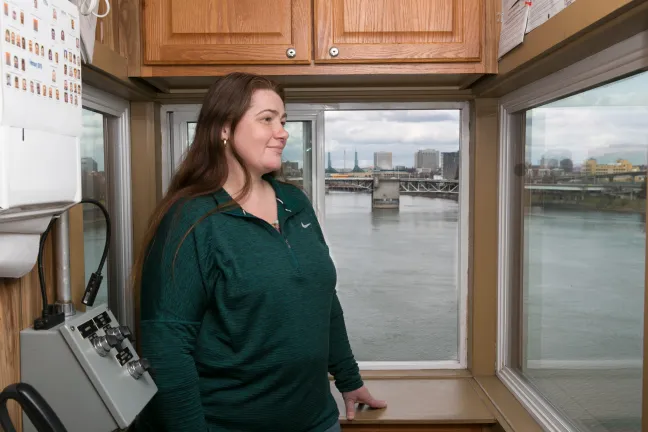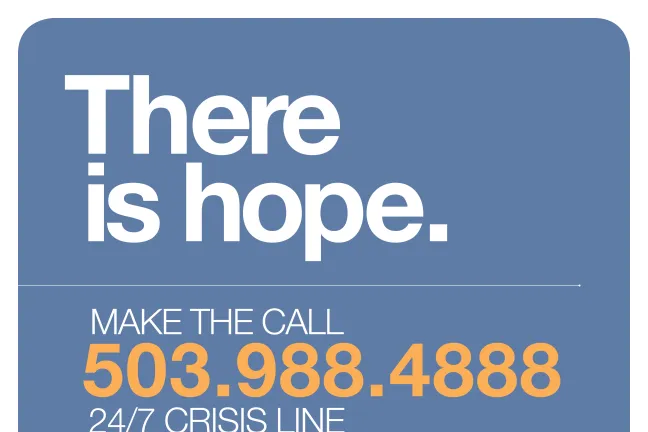From her small office in the operator’s tower on the Hawthorne Bridge, Tammy Vanderlinden can see for miles.
Vanderlinden operates one of Multnomah County’s four historic drawbridges that span the Willamette River. Her job is to be prepared. All day, she monitors traffic that travels using the bridge she’s assigned to, by water or road. Live cameras show her different vantage points on the structure.
Bridges are an iconic part of Portland's landscape, with five County-owned structures connecting the west and east sides of Portland. Several hundred thousand people cross the County’s bridges daily. A team of more than 30 County staff work to maintain the bridges and lift them for river traffic.
“We’re kind of like the eyes and ears of the Willamette,” she said.
At any moment Vanderlinden must be ready to act. Her responsibilities include more than just being available for a routine bridge lift. She also must be prepared for the unexpected. She’s seen everything — from fender benders to drawbridges stuck in the up position.
She’s even had to save a life. She can remember several times when she’s called 911 or rushed to help someone standing on one of her bridges, who was clearly struggling with thoughts of suicide.
“We are always looking and watching and listening,” Vanderlinden said. “Whenever I see someone who needs help, I think, ‘That could be one of my children, or one of my friends.’”
Suicide is a leading cause of death for all adults in the United States, and the second leading cause for young people ages 15-24. That’s why Multnomah County posts signs reminding people that “There is hope” and featuring the number for County’s 24/7 Mental Health Call Center.
Now, the Multnomah County Bridge Shop is offering bridge staff new tools to respond to people experiencing a mental health crisis. They’re collaborating with the Health Department to train, staff and create protocols for responding to mental health emergencies. Soon, the plan will go into effect. It aims to better prepare staff to respond to emergencies, manage emotional stress, and improve safety on the bridges.
“We have had staff stop people from attempting suicide or hurting themselves,” said bridge manager Jon Henrichsen. “What interests me is how we can provide staff tools so they know what to do, and if they decide to help, how they can do it safely and without physically restraining them.”
With staff working on the County’s bridges so frequently, they’re often the first to notice when something seems not quite right. And they’ve become adept at recognizing the signs of someone contemplating suicide.
One time, Vanderlinden noticed something suspicious during one of her shifts. Traffic had come to a stop for no apparent reason. She looked out from her tower and noticed someone sitting against the railing on the drawbridge span.
“I called another bridge operator and told them I was leaving the tower to check on the guy,” Vanderlinden said. “I went down there and he was crying and was talking about killing himself. I sat down next to him, just so I could be at his level. I listened to him tell me how he was feeling. I didn’t want to leave him, so I asked for another operator to call 911.”
She stuck with the man until an ambulance came. Looking back, she said talking with him helped buy crucial time — when a single moment might mean life or death.
“Survivors always say that they immediately regretted their decision to end their lives,” Vanderlinden said. “Intervening gives them another chance to think about it. If they go and get in the ambulance, at least they are getting some help from somebody.”
Kristian Williams is a bridge operator. He typically works the swing shift on the Hawthorne and Morrison bridges, watching the light traffic that crosses through the night. He said being a bridge operator is his dream job.
Williams said most of the time his job is “extremely relaxing.” Only rarely does he encounter stressful situations, he said.
In one of those moments, he saw a woman standing looking dangerously over the edge of the bridge, sobbing. So Williams left his post in the operator’s tower and asked if she was okay. They stood together, then talked for a few minutes, and eventually she felt better and left. Williams was relieved.
“I didn’t know whether she was thinking about ending her life,” Williams said. “But I wasn’t going to assume she wouldn’t. So I came down and talked to her.”
Intervening in a tense situation can be dangerous and difficult for those without formal training. But experts say that talking to someone who shows signs of a mental health crisis might save a person’s life.
As the County’s suicide prevention coordinator, Mandy Kubisch offers mental health and suicide prevention trainings through the Get Trained To Help initiative. All trainings are free and open to the public.
Last month, the County bridge team went to Kubisch and her supervisor, Leticia Sainz, for help improving their response to mental health crises on their work sites.
Kubisch met with all of the bridge operators and maintenance staff to hear their experiences, how they have responded in the past, and how those incidents have affected them personally. Then she met with Bridge Shop leadership.
After the meetings, she created recommendations that included training opportunities for staff, and ways to help employees navigate the emotional pain of a traumatic event. She recommended developing safety standards and procedures for how staff should respond to someone who might try to attempt suicide.
Kubisch said she walked away from her meetings amazed by the team’s courage. She heard stories of how quick thinking by a bridge staff member has saved people’s lives. She also heard about people those bridge staff could not save, and who jumped. And she listened to how those deaths affected the entire team.
“The bridge staff are the unsung heroes of our organization,” Kubisch said. “They keep our community moving in a lot of ways and help keep us safe. We all should have a working knowledge of how to handle these difficult situations, and they are leading by example.”
Today, leaders in the Bridge Shop are working to finalize new policies based on the recommendations from the Health Department. With new procedures in place, the team hopes to be better prepared to respond when someone is in danger. They also want to ensure staff feel supported in the event of an emergency.
Henrichsen said the plan will bring the team leaps and bounds ahead of where they were previously. With his 26 years working on the Bridge team, he said he’s excited that the team is making mental health a priority.
“Because of where we work, we happen to encounter more people who are at a higher risk of dying by suicide,” Henrichsen said. “For those people’s sake, and our sake, we’ve thought about how we can improve, and now staff are getting the tools they need to better do their jobs.”
For staff working on the bridges, the policies are coming at the right time. For years, they’ve wondered how they can balance their job responsibilities with the instinct to help. Now, they say they’re getting an answer.
“We’ve been wanting this for as long as I’ve been working here,” Williams said. “Often times, we’re the first people to respond when someone is in crisis. I’m relieved we’re finding out how to take care of ourselves and others when someone’s life is on the line.”


